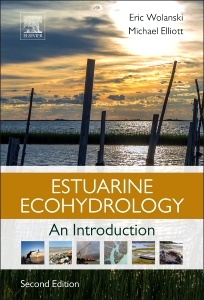Estuarine Ecohydrology (2nd Ed.) An Introduction

Estuarine Ecohydrology, Second Edition, provides an ecohydrology viewpoint of an estuary as an ecosystem by focusing on its principal components, the river, the estuarine waters, the sediment, the nutrients, the wetlands, the oceanic influence, and the aquatic food web, as well as models of the health of an estuary ecosystem.
Estuaries, the intersection of freshwater and coastal ecosystems, exhibit complex physical and biological processes which must be understood in order to sustain and restore them when necessary.
This book demonstrates how, based on an understanding of the processes controlling estuarine ecosystem health, one can quantify its ability to cope with human stresses. The theories, models, and real-world solutions presented serve as a toolkit for designing a management plan for the ecologically sustainable development of estuaries.
1. Introduction2. Estuarine water circulation3. Estuarine sediment dynamics4. Tidal wetlands5. Estuarine ecological structure and functioning6. Ecohydrology models7. Ecohydrology solutions
Eric is a member of the editorial board of Journal of Coastal Research, Journal of Marine Systems, Ecohydrology and Hydrobiology, and Continental Shelf Research. He is a member of the Scientific and Policy Committee of the Japan-based International Center for Environmental Management of Enclosed Coastal Seas, a Visiting Professor at the Chinese Academy of Sciences, and a member of the College of Experts of the Australian Research Council.
Professor Michael Elliott is the Director of the Institute of Estuarine & Coastal Studies (IECS) and Professor of Estuarine and Coastal Sciences at the University of Hull, U.K. He is a marine biologist with wide experience in teaching, research, advisory and consultancy work in estuarine and marine aspects of ecological components and communities, and the impacts of human activities, as well as policy, governance, and management of estuaries and coasts. He is a Fellow of the Royal Geographical Society and of the Society of Biology. Mike has published widely, coauthoring/coediting 15 books and contributing to over 200 scientific publications,
- Provides a sound knowledge of the physical functioning of an estuary, a critical component of understanding its ecological functioning
- Ideal reference for those interested in marine biology, oceanography, coastal management, and sustainable development
- Describes the essentials behind conceptual and numerical models of the health of an estuary ecosystem and how to use these models to quantify both human impacts and the value of remediation and management measures
- Chapters are written in an accessible way that encourages collaboration between aquatic, marine, and wetland biologists, ecologists, oceanographers, geologists, geomorphologists, chemists, and ecosystem modelers
- Covers the physical, chemical, and biological elements of estuary environments, indicating that the essence of an estuary’s functioning lies in its connectivity with the adjacent catchment and the marine/coastal system
Date de parution : 08-2015
Ouvrage de 322 p.
15x22.8 cm
Thèmes d’Estuarine Ecohydrology :
Mots-clés :
Estuary; ecohydrology; marine biology; oceanography; coastal management; sustainable development



